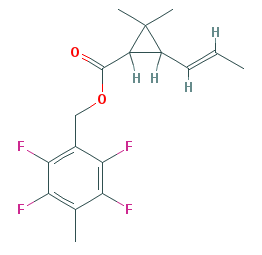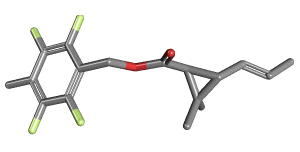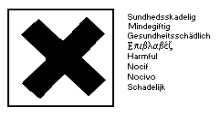Profluthrin
Profluthrin (2,3,5,6-tetrafluoro-4-methylbenzyl (EZ)-(1RS,3RS;1RS,3SR)-2,2-dimethyl-3-prop-1-enylcyclopropanecarboxylate, CAS#223419-20-3), a newly discovered insecticide, provides high efficacy against fabric pests and also has relatively high vapor pressure and low mammalian toxicity, which means Profluthrin has various superior properties as an active ingredient of moth proofers. In addition, it has excellent activity against sanitary pests like flies, mosquitoes and cockroaches. Profluthrin was launched in 2004 in Japan, and several companies have adopted it for their household insecticide products. In this report we will introduce he outline of the new synthetic pyrethroid Profluthrin.
Uses
The lethal effects of profluthrin on Tineola bisselliella, inea translucens and Attagenus unicolor lar vae were as llows, respectively: approximately four times greater, ore than five times greater and approximately eight mes greater than that of EZ-empenthrin.
Profluthrin demonstrated efficacy againstTineola bisselliella and Tinea translucens lar vae by a factor of approximately four times greater than that of EZ-empenthrin. It also showed high efficacy against Attagenus unicolor lar vae which was approximately eight times greater than that of EZ-empenthrin. It has therefore been revealed that profluthrin possesses high vapor action against the lar vae of fabric pests.
When using profluthrin as an active ingredient for moth-proofing products, such products will be used in carton cases, drawers and wardrobes that contain cloth-ing. Therefore, several efficacy tests were conducted in such practical conditions.
(1) Egg-Hatching Inhibition Effect in a Drawer Test The practical efficacy of each test sample was evalu-ated, assuming usage in carton cases and drawers, through the following procedure: Filter papers impreg-nated with agent were placed in a carton case containing clothes (with an approximate capacity of 50 L); and the effect of the test sample on Tineola bisselliella eggs was obser ved each time a specific time inter val had passed.
Profluthrin demonstrated high efficacy (egg-hatching inhibition effect and lethal effect on newly hatched lar - vae) against Tineola bisselliella eggs under a dosage of 20 mg during the period from one to six months after the initiation of the test. This result was nearly equivalent to that of a fivefold quantity of EZ-empenthrin and signifi- cantly greater than that of 80 g of p -dichlorobenzene.
(2) Egg-Hatching Inhibition Effect in a Wardrobe Test Assuming the use in wardrobes, the practical efficacy of each agent against Tineola bisselliella was evaluated using a wardrobe.
Profluthrin demonstrated pest-control rates of
100%
egg-hatching inhibition and lethal rate of newly hatched
ar vae) against Tineola bisselliella eggs under a dosage
of 0.1g during the period from one to six months after
he initiation of the test.
This result was equivalent to that of a fivefold quantity
of EZ-empenthrin. On the contrar y, p -dichlorobenzene
did not show sufficient efficacy during the period from the
initiation of the test until six months after the test,
even with a dosage of 120 g.
(3) Oviposition Inhibition Effect on Fabric Pests Worm-hole damage can be caused by the larvae of fabric pests through the following process: The adults of Tinea translucens, Tineola bisselliellaand Attagenus unicolor fly into houses, enter drawers and wardrobes, lay eggs on clothing, and finally the hatched lar vae feed on fabrics. For this reason the insecticidal activity against such lar vae and egg-hatching inhibition effect on eggs laid on clothes were conventionally considered important evaluation criteria. However, it can be assumed that it is also important to prevent the adults of fabric pests from coming into contact with clothing and/or laying eggs in order to prevent worm-hole damage. Therefore, the oviposition inhibition effect of profluthrin on those adults was evaluated in a 28m3 test chamber using a wardrobe with a capacity of approxi-mately 700 L.
Profluthrin possesses high efficacy not only
against
fabric pests but also sanitar y pests (houseflies, mos-quitoes,
cockroaches) and nuisance pests (moth flies,
fruit flies).
(1) Lethal Effects on Sanitar y Pests
The lethal effect of profluthrin against various sani-tar y pests
was investigated by a topical application
method and compared with that of EZ-empenthrin.
Profluthrin showed a high lethal effect on the adults of
Culex pipiens pallens, Culex pipiens molestus and Aedes
albopictus, and its relative insecticidal activity was
ap-proximately ten to twenty times greater than that of
EZ-empenthrin. However, the lethal effect of profluthrin
against Musca domesticaadults was nearly equal to that
of EZ-empenthrin, while its lethal effect against Blat-tella
germanica adults was slightly greater than that of
EZ-empenthrin.
(2) Efficacy against Mosquitoes in a Glass Chamber Test The knockdown effects of profluthrin against various species of mosquitoes were observed in a glass chamber with a capacity of 0.34 m3 and compared to those of EZ-empenthrin. The following procedures were undertaken to obser ve the knockdown effects: A piece of filter paper impregnated with each test sample was suspended from the ceiling of the chamber. The test in-sects (adults) were then released into the chamber. The number of knocked-down insects was counted each time the specified time inter val had elapsed, and the time re-quired for knocking down half of the test insects (KT 50) was measured. Profluthrin, vaporizing under ambient temperature, demonstrated excellent fast-acting efficacy against the adults of Culex pipiens molestus and Aedes albopictus . It also showed a knockdown effect greater than that of EZ-empenthrin with just one-fourth the dose.
(3) Efficacy against Nuisance Pests by Vapor Action Test To investigate the vapor action of profluthrin against nuisance pests, the vapor action test was conducted in a small space under ambient temperature and compared to the vapor action of EZ-empenthrin. Adults were re-leased into a 200 mL plastic cup, the top of which was covered with a net in order to prevent the insects from directly coming into contact with the treated surface. The cup was then placed upside down on the treated alu-minum plate. Lastly, the number of knocked-down in-sects was counted each time the specified time inter val had elapsed.
Profluthrin showed excellent knockdown effects on Clogmia albipunctata and Drosophilamelanogaster adults, which were much greater than those for the equivalent amount of EZ-empenthrin.
Package & Transport
Package Size: N.W: 20/25 Kg G.W: 24/29 Kg;
UN Number: 3352
Hazard Class: 6.1
Notice
1. Avoid mixture with food and forage, and avoid reach of children.
2. Use respirator and glove when handling, clean completely with soap and water when splashed into skin.
3. Destroy and bury waste drum or dip it into alkali liquid for several days for recycling uses.
4. Storage in dry, cold area and avoid light.
Profluthrin

|
|
| Molecular Formula | C17H18F4O2 |
| Molar Mass | 330.32 g/mol |
IUPAC Name
2,3,5,6-tetrafluoro-4-methylbenzyl (EZ)-(1RS)-cis-trans-2,2-dimethyl-3-prop-1-enylcyclopropanecarboxylate
Identifiers
| CAS Number | 223419-20-3 |
| ChemSpider | 16738651, 11677369 |
| RTECS Number | GZ1975000 |
| KEGG | D10197 |
| PubChem | 11609617 |
| Jmol-3D images | Image 1, Image 2 |
SMILES[show]
C/C=C/C1C(C1(C)C)C(=O)OCC2=C(C(=C(C(=C2F)F)C)F)F
InChI[show]
Properties
| Appearance | Pale yellow to light yellow clear liquid |
| Density | 1.19 g/cm3 (17.5 ℃) |
| Melting point | <25 ℃ |
| Boiling point | 323 ℃ |
| Vapour pressure | 10.3 mPa at 25℃ |
| Solubility in water | 0.16 mg/L |

 English
English 中文简体
中文简体






 Arabic
Arabic  French
French  Italian
Italian  German
German  Japanese
Japanese  Korean
Korean  Portuguese
Portuguese  Russian
Russian  Spanish
Spanish 